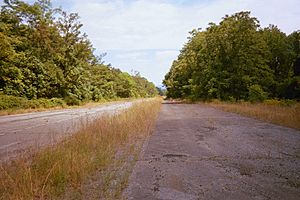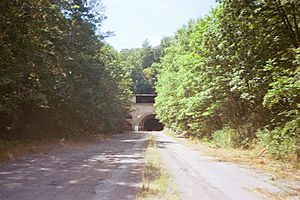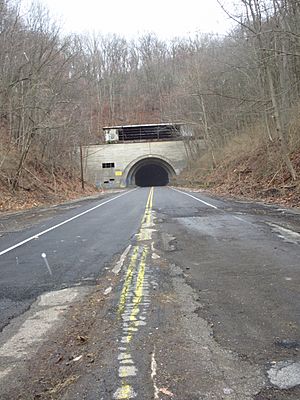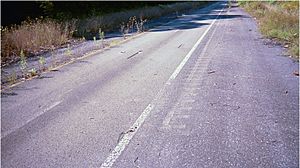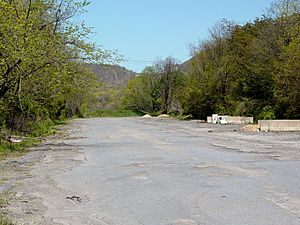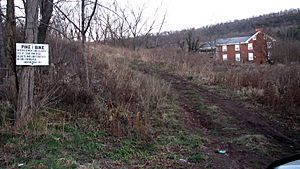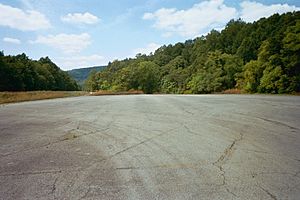Abandoned Pennsylvania Turnpike facts for kids
Quick facts for kids Abandoned Pennsylvania Turnpike |
|
|---|---|
| Length | 13 miles (21 km) |
| Trailheads | Tannery Road, Breezewood Pump Station Road, Fulton County |
| Use | Hiking, biking, recreation |
| Sights | Rays Hill Tunnel and Sideling Hill Tunnel |
The Abandoned Pennsylvania Turnpike is a 13-mile (21 km) long section of the Pennsylvania Turnpike that is no longer used. It was closed in 1968 because a newer, wider road was built to help with traffic jams. This old section includes two tunnels, the Sideling Hill Tunnel and Rays Hill Tunnel, and a rest stop that were all bypassed.
This abandoned part of the turnpike is located just east of Breezewood, where Interstate 70 (I-70) and I-76 meet. Interestingly, this section of road was once part of a railroad called the South Pennsylvania Railroad.
Contents
History of the Abandoned Turnpike
Why the Turnpike Was Built
When the Pennsylvania Turnpike first opened in 1940, people called it the "Tunnel Highway." This was because it had seven tunnels that went through mountains. These tunnels were: Blue Mountain, Kittatinny Mountain, Tuscarora Mountain, Sideling Hill, Rays Hill, Allegheny Mountain, and Laurel Hill.
Each tunnel only had one lane of traffic going in each direction. This meant cars had to slow down and merge, which could cause problems. These tunnels were originally dug for the South Pennsylvania Railroad, but the railroad was never finished.
Solving Traffic Jams
By the late 1950s, the turnpike was very busy. The two-lane tunnels became a big problem, causing huge traffic jams, especially in the summer. The Pennsylvania Turnpike Commission (PTC), which manages the road, looked for ways to fix this. They considered either making the tunnels wider or building new roads around them.
In 1960, the PTC decided to build a second tunnel tube at Allegheny Mountain. They also planned a new four-lane road to bypass the Laurel Hill Tunnel. Bypassing a tunnel was faster and cheaper than digging a new one.
Work on the Laurel Hill bypass began in September 1962. This new road had a wide grassy area in the middle and special lanes for trucks going uphill. It opened in October 1964. The second tube at Allegheny Mountain Tunnel opened in stages in 1965 and 1966.
The Big Bypass of 1968
The most famous bypass happened on November 26, 1968. This is when the Sideling Hill Tunnel and Rays Hill Tunnel were bypassed. A new 13-mile (21 km) highway was built around them. The old Cove Valley Travel Plaza, a rest stop, was also closed. A new, modern rest stop called Sideling Hill Travel Plaza was built instead.
What Happened After Abandonment?
Today, the Abandoned Turnpike is a popular spot for visitors. In 2001, the PTC sold most of the property for just $1 to the Southern Alleghenies Conservancy (SAC). This group works with others, like Friends of the Pike 2 Bike, to turn the old road into a bike trail.
Even though it's officially closed to cars, people can ride bikes there at their own risk. You need to wear a helmet and use lights in the tunnels. Because this old road was once part of a railroad, it's unofficially known as a "rail trail." The PTC still owns a small part of the road for maintenance.
Over the years, the tunnel entrances have been damaged by people, and signs were taken. However, the tunnels themselves are still strong, even though they haven't been maintained for decades.
In 2005, a study looked at how to make the trail better for cyclists, hikers, and even horseback riders. As of 2007, the ownership of the trail was changing to Bedford County. This helps the trail get grants, but the Friends of the Pike 2 Bike group still manages it.
Later Uses of the Abandoned Turnpike
The Abandoned Turnpike has been used for many different things since it closed to regular traffic.
- In the early 1970s, scientists used the Rays Hill Tunnel to test how much pollution came from unleaded gasoline. They used a Plymouth Satellite car for these tests.
The PTC and PennDOT (Pennsylvania Department of Transportation) used the highway to train maintenance workers. They also tested rumble strips, which are grooves in the road that make noise when you drive over them to warn drivers.
- The military has used the highway for training. They even considered using the tunnels to store weapons or the open road for aircraft. In the early 2000s, soldiers trained there for missions, even after the land was sold.
- The site of the old Cove Valley Travel Plaza was used as a shooting range by the Pennsylvania State Police. It's not used for that anymore, but you might still see old warning signs.
- In 2008, parts of the highway were used to film the movie The Road, starring Viggo Mortensen. The film crew even fixed up the outside of the Ray's Hill Tunnel for the movie.
How to Access the Abandoned Turnpike
In 2005, the PTC made it harder for cars to get onto the abandoned turnpike. They tore down two bridges that went over other roads. This helped prevent cars from entering and also saved money on bridge repairs.
There were plans to build a new access road for the public, but it didn't happen right away. The Friends of the Pike 2 Bike group is trying to get money to build an access road and even rebuild an old toll booth. This toll booth would collect donations for parking to help pay for trail upkeep.
There are three main ways for the public to get onto the abandoned highway:
- Tannery Road and US 30: This access point is near the western end of the abandoned turnpike, just east of the Breezewood interchange. You can park in front of an orange fence and walk up a small hill to reach the trail. The Rays Hill Tunnel is about two miles east from here.
- Pump Station Road: At the eastern end of the turnpike, there's a parking lot off Pump Station Road, north of US 30. This spot is near where the old Cove Valley Travel Plaza used to be. The Sideling Hill Tunnel is about one mile east from here.
- Oregon Road: This is a forest service path that starts near the intersection of US 30 and Pennsylvania Route 915. Oregon Road runs next to the abandoned highway for a long way. There are several clearings where you can park and get onto the trail. These spots are between the two tunnels: Rays Hill is about three miles west, and Sideling Hill is about two miles east.
Other Tunnel Bypasses
The Abandoned Pennsylvania Turnpike is probably the most famous example of a tunnel bypass on a toll road. But there are others:
- The Laurel Hill Tunnel was bypassed four years before the Sideling Hill and Rays Hill tunnels.
- The Memorial Tunnel on the West Virginia Turnpike was bypassed in 1987. This was done to make the highway meet Interstate standards so it could become part of I-77 and I-64.
The PTC thought about bypassing the Lehigh Tunnel on the Northeast Extension of the turnpike. But they decided to build a second tunnel tube instead, because a bypass would have cost more and made the highway longer.
- The PTC has also been thinking about bypassing the Allegheny Mountain Tunnel or building a third tunnel tube there to help with traffic. Planning for this started again in 2014.
See Also
- Laurel Hill Tunnel
- Rays Hill Tunnel
- Sideling Hill Tunnel


